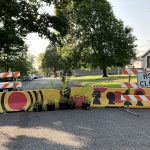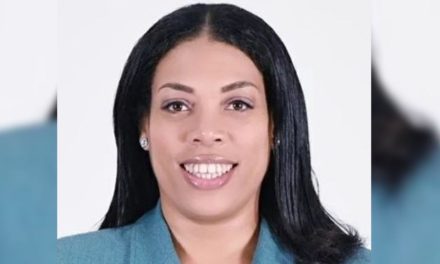Birmingham has put up barriers at 18 entry points and alleys within the East Lake neighborhood as part of the Safe Streets initiative. Since the initiative’s launch in July 2024, the barriers have been a hot topic for many East Lake residents. (Alaina Bookman, AL.com)
” data-medium-file=”https://www.birminghamtimes.com/wp-content/uploads/2024/08/Alaina-1–300×169.jpg” data-large-file=”https://www.birminghamtimes.com/wp-content/uploads/2024/08/Alaina-1–1024×576.jpg” tabindex=”0″ role=”button” />
By Alaina Bookman | abookman@al.com
This is another installment in Birmingham Times/AL.com/CBS42 joint series “Beyond the Violence: what can be done to address Birmingham’s rising homicide rate.” Sign up for the newsletter here.”
For weeks, cars have tried to drive into Birmingham’s East Lake neighborhood, only to be stopped by road closed signs and bright yellow concrete barriers.
Project Safe Streets is a City of Birmingham four-month pilot program that aims to make the neighborhood and city safer by controlling and limiting access points to the neighborhood. Officials hope to deter speeding, shootings, theft, prostitution and violent crime. City officials also are identifying abandoned properties and illegal dumping sites for cleanup and revitalization. The city has put up barriers at 18 entry points and alleys within the neighborhood.
Since the initiative’s launch in July, the barriers have been a hot topic for many East Lake residents. For some residents, the barriers are a nuisance and a punishment. For others, they are a symbol of safety and hope.
Marquis Tucker has lived in East Lake for 23 years and was one of the artists who painted the barriers with black and red abstract shapes, green peace lilies and children. He said the barriers represent a future for his 2-year-old son.
“Painting the children onto these barriers not only reminds us of the losses we’ve had to violent crimes but shows that there’s a future that is still living in these communities that deserve to see tomorrow,” Tucker said.
“I think the barriers are definitely a great thing to have in place. Something needed to be done and things have improved a lot.”
Birmingham is on track to have the most number of homicides in a year in recent memory; so far in 2024, 108 people have been killed, including 8 justifiable death rulings and eight children who have been killed. The youngest victim was 5-year-old Landon Brooks, who died after being shot.
The other seven children were Markell Sanders, 15; Aston Starky, 13; Jonathan O’Dell Thomas Jr., 18; Jaylin Lee Jenkins, 16; Jaquavius James Weston, 18; Cornelia Rose Lathan, 15; and Prentice Lovell Little, 15.
East Lake has seen several violent crimes and deaths in recent months; in May, before the barriers were deployed, a 10-year-old boy was shot while walking in East Lake Park.
In June, Kameron Connell, 30, was shot and killed in an East Lake parking lot near a dice game.
Later that same month, a shootout on First Avenue North in front of East Lake Park left Martavius Williams, 19, dead and two other people seriously injured. Shot Spotter registered more than 50 rounds fired.
The city’s homicide spike comes as many cities across the United States have reported a decrease in violent crimes.
” data-medium-file=”https://www.birminghamtimes.com/wp-content/uploads/2024/08/Alaina-3-300×169.jpg” data-large-file=”https://www.birminghamtimes.com/wp-content/uploads/2024/08/Alaina-3-1024×576.jpg” tabindex=”0″ role=”button” class=”size-full wp-image-122398″ src=”https://www.birminghamtimes.com/wp-content/uploads/2024/08/Alaina-3-scaled.jpg” alt=”” width=”2560″ height=”1440″ srcset=”https://www.birminghamtimes.com/wp-content/uploads/2024/08/Alaina-3-scaled.jpg 2560w, https://www.birminghamtimes.com/wp-content/uploads/2024/08/Alaina-3-300×169.jpg 300w, https://www.birminghamtimes.com/wp-content/uploads/2024/08/Alaina-3-1024×576.jpg 1024w, https://www.birminghamtimes.com/wp-content/uploads/2024/08/Alaina-3-768×432.jpg 768w, https://www.birminghamtimes.com/wp-content/uploads/2024/08/Alaina-3-1536×864.jpg 1536w, https://www.birminghamtimes.com/wp-content/uploads/2024/08/Alaina-3-2048×1152.jpg 2048w, https://www.birminghamtimes.com/wp-content/uploads/2024/08/Alaina-3-747×420.jpg 747w, https://www.birminghamtimes.com/wp-content/uploads/2024/08/Alaina-3-640×360.jpg 640w, https://www.birminghamtimes.com/wp-content/uploads/2024/08/Alaina-3-681×383.jpg 681w” sizes=”(max-width: 2560px) 100vw, 2560px” />
Measuring Success
Since the implementation of the Safe Streets initiative, the city has hauled more than 292 tons of trash to the landfill, made more than 45 arrests, identified over 35 structures for condemnation, cut over 120 overgrown lots and written more than 100 traffic violations just in the East Lake area, according to city officials.
“We do see some impact being made,” Alicia Lumpkin, the City of Birmingham director of process improvement, said.
Mayor Randall Woodfin told AL.com in July that the city would track and assess the effectiveness of the East Lake program at the end of the pilot to determine if the initiative will continue or if the city will reopen the streets.
The city will track information from the police department’s Shot Spotter program, 911 calls and incidents of illegal dumping to compare to previous years to determine if the barriers made a substantial difference.
City officials will also periodically check in on residents to gauge their opinions.
Resident Responses
Before putting up the barriers, City of Birmingham officials canvassed the East Lake neighborhood and hosted neighborhood meetings to hear from residents about their thoughts and gain their support on the initiative.
Warren Seay, who has lived in East Lake for 21 years, said Woodfin came to his door in June to talk to him. He told the mayor he didn’t want the barriers.
“Everybody on this block told him we didn’t like it and he still did it,” Seay said. “I’m handicapped and I have to go all around the world just to get out of my own neighborhood. I have to go way out of my way just to get home.”
Lumpkin said city officials mostly heard support, so in early July, workers placed the barriers.
“We decided to try out a pilot program to see if we can curb some of these issues happening in the community. The goal is to stop so many people from just going straight through the community, committing crimes and then leaving,” Lumpkin said.
Virginia Morgan and Mary Buchanan said they never heard from the city before the barriers went up. They left their homes one day only to find that they were blocked into their own neighborhood.
“To me, it feels like I’m being punished just for living there. And it feels less safe to me…It prevents people who live here from driving in and out of our own neighborhood. It makes me feel trapped,” Morgan said.
“I feel like I’m in a prison camp,” Seay agreed.
Buchanan, who has lived in East Lake for 25 years, said she thinks the barricades are “ridiculous” because she believes there is not a lot of crime on her side of the neighborhood.
Morgan, Buchanan and Seay said they are concerned they won’t be able to quickly navigate out of the neighborhood during an emergency or that police and firefighters will take too long to reach a resident in need because of the barriers.
“I had to U-turn five different times to get to where I was going because of the barricades,” Buchanan said.
At a community meeting at the beginning of August, one resident said the barriers were “thoroughly confusing.”
But other residents said they have seen the barriers make a positive difference.
Felisa Woods, an East Lake resident, was in a car accident that totaled her car after a reckless driver ran a stop sign on Division Ave.
“By having those streets blocked, they have cut a lot of the speeding and people just running the stop sign,” Woods said.
As a part of the Safe Streets initiative, the city added four-way stop signs, barriers and speed bumps onto Division Ave.
“My kids feel a lot safer playing outside because that roadblock is there. I see the police patrolling the neighborhood more. I see less trash. I’ve seen a lot of positive things,” Woods said.
Next Steps
The Safe Streets initiative is similar to one launched in 2023 by the Housing Authority of the Birmingham District where streets were closed with concrete barriers to limit easy access to high-crime areas.
“Since installing these blockages, there’s been a night and day difference in criminal activity. Children can play outside safely. Residents are safer. The initiative has been very effective in the reduction of crime,” Ken Foreman, director of public safety with the housing authority, said.
Research has found that offenders are less likely to commit crime in areas that are unfamiliar and difficult to access. Drive-by shootings may be prevented because cars cannot easily enter a roadblocked street.
Birmingham is not the first city to implement roadblocks as a crime deterrent. Other cities have had mixed results with their own initiatives over the years.
In 1992, a Dayton, Ohio neighborhood, deployed a street closure initiative and witnessed a 40% decline in violent crime within one year.
In 2000, Charlotte, North Carolina, started a similar initiative with only two barricades on the neighborhood’s busiest routes. Within one year, the neighborhood saw a 54% reduction in violent offenses.
Despite the initiative’s success, pressure from residents who believed the barriers were not a substitute for policing resulted in the discontinuation of the project.
In 2022, Jackson, Mississippi had to make changes to their “Ticket Arrest Tow” initiative after a class action lawsuit claimed that the roadblocks violated Black residents’ rights, according to a Mississippi Free Press report.
The East Lake Safe Streets pilot will end in October. While some residents will be glad to see the barriers go, others will want them to stay.
Alaina Bookman’s violence prevention reporting at AL.com is supported by grants and individual donations.











